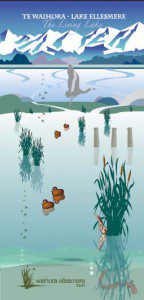About the Lake
Te Waihora / Lake Ellesmere is New Zealand’s 5th largest lake, its largest coastal lagoon, an internationally recognised wetland, home to 167 species of bird and 40 generations of human history.
Human History
Maori refer to the Lake as ‘Te Kete Ika’ or ‘The Fish Basket’ in reference to the bountiful resources (mahinga kai) of the lake which allowed for sustenance all year round. It was revered as the most bountiful site in the South Island (Te Waipounamu). The lake provided flounder, eels, whitebait, pingao, paru, harekeke, brown teal and swamp hen, and many more resources. The lake bed was vested in the Ngai Tahu tribe as part of the 1996 treaty settlement.
The name Ellesmere comes from the Earl of Ellesmere who was a member of the Canterbury Association and promoted the early settlement of Canterbury. European settlers drained the wetlands surrounding the lake, turning the area into highly productive farmland. The vast forests of Banks Peninsula were felled for timber and to provide land for grazing; while the lake was an important waterway for shipping timber.
 Lake Information Brochure
Lake Information Brochure
A brochure, published by WET in 2008 with assistance from the Biodiversity Advice Fund and Environment Canterbury, provides an overview of the ecology, recreational use, Lake management and history of the Lake. A map of the Lake indicates the key access points, roads, tracks and reserves. The brochure can be downloaded here (2MB), and is also available from some libraries or you can contact us to ask for a copy.

 Lake Information Brochure
Lake Information Brochure